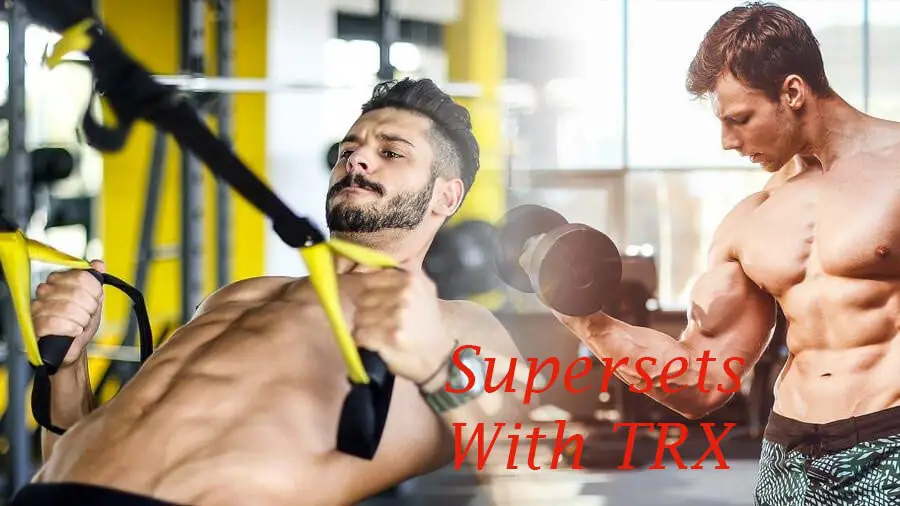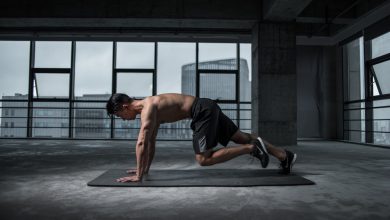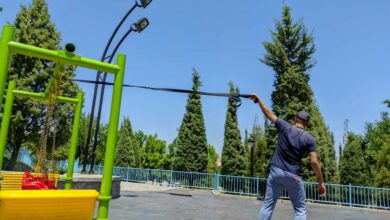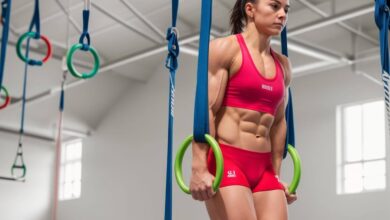Bodybuilders and fitness enthusiasts incorporate different strategies in their training plan to gain the most advantages of their training session. Many of such techniques are adaptable to bodyweight exercises. Bodyweight superset is an advanced hypertrophy set for gaining muscle mass.
Table of Contents
What is Bodyweight Superset Workout?
In a typical strength training session, you do one set then about 2 minutes of rest, and go for another. There is a short interval between sets in which you can rest or drink some water.
However, in a bodyweight superset workout, after performing one set from one exercise you jump to another exercise and perform another set without any rest interval in between. Continue with this pattern until you need a break, and this becomes one superset.
Bodyweight superset is harder than straight body weight exercises and it is suitable for advanced athletes.
Benefits of Bodyweight Superset
- Bodyweight superset workouts are time efficient. You can perform twice as much of the exercise volume as in typical resistance training. In practice, during the time that is dedicated to rest interval in straight sets, you perform another exercise. This means in effect, you perform two exercises back-to-back.
- According to a study, reducing rest times and increasing repetitions results in better anabolic conditions in the body, including increased hypertrophic hormones such as testosterone and growth hormone. Bodyweight supersets increase the volume of exercise at a given time and hence improve muscle growth.
- Bodyweight superset workout is more efficient compared to the traditional weight training superset. In bodyweight superset you can quickly switch from one exercise to another at no time. You don’t have to change weights or replace equipment.
- Implementing bodyweight superset for mass, you don’t have to increase the amount of resistance like the way you do in traditional hypertrophy sets. This is particularly helpful when you want to overload your muscles with body weight and without using free weights.
- Bodyweight superset is a way to diversify your workout routine and add variety to the exercise. It helps to prevent muscle adaptation and stimulates growth.
Active Rest in Bodyweight Superset
The idea of superset is practicing another exercise during the rest period of an standard set. This is also called active rest which means you are resting that muscle but at the same time training another muscle. This results in elevated heartbeat and extra pump in muscle due to increased blood flow. Take 1 to 2 minutes superset rest between sets.
TRX Superset Workout
A TRX superset workout is a type of workout that involves performing two exercises back-to-back with no rest in between. This type of workout is designed to challenge your muscles and help you burn more calories.
To do a TRX superset workout, you will need a TRX suspension trainer. To start, choose two exercises that work different muscle groups. For example, you could do a TRX push-up and a TRX row. Once you have chosen two exercises, perform them back-to-back with no rest in between. Repeat this for 3-4 sets of each exercise. As you get stronger, you can increase the number of sets and repetitions that you do.
The benefits of a TRX superset workout are that it provides a full-body workout that can help you to build strength, increase endurance, and improve balance and stability. It also allows you to perform a large number of exercises in a relatively short amount of time, making it a great option for people with busy schedules.
Types of Supersets in Calisthenics Exercises
There are different methods for supersetting in weight training, and we can apply them to calisthenics exercises too.
Pre-Exhaustion Supersets in Calisthenics
Pre-exhaustion supersets begin with an isolation exercise. The first set starts with a single joint exercise and the second is a compound move.
Read about, isolation exercises and compound exercises with hypertrophy sets.
An example of a pre-exhaustion superset with TRX is pairing TRX chest fly with press up.
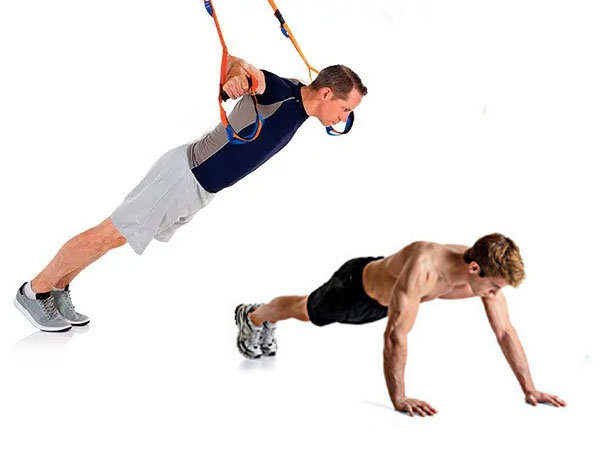
Do a set of TRX chest fly with locked elbows that targets mostly chest muscles and pre-exhaust them, then go for a press-up that is a compound exercise and do another set. In TRX chest fly you target chest muscles without the help from triceps until fatigue and in press-up, you recruit triceps as well. You can replace press up with other compound exercises such as TRX chest press or TRX dip.
Pre-exhaustion superset examples with TRX
Chest TRX superset
| SUPERSET 1 | SUPERSET 2 | SUPERSET 3 | SUPERSET 4 | SUPERSET 5 |
| TRX chest fly | TRX chest fly | TRX chest fly | TRX chest fly | TRX chest fly |
| Press up | Press up | Press up | Press up | Press up |
| Rest: 2-3 mins | Rest: 2-3 mins | Rest: 2-3 mins | Rest: 2-3 mins | Rest: 2-3 mins |
Back TRX superset
| SUPERSET 1 | SUPERSET 2 | SUPERSET 3 | SUPERSET 4 | SUPERSET 5 |
| TRX Straight Arm Lat Pulldown | TRX Straight Arm Lat Pulldown | TRX Straight Arm Lat Pulldown | TRX Straight Arm Lat Pulldown | TRX Straight Arm Lat Pulldown |
| TRX back row | TRX back row | TRX back row | TRX back row | TRX back row |
| Rest: 2-3 mins | Rest: 2-3 mins | Rest: 2-3 mins | Rest: 2-3 mins | Rest: 2-3 mins |
Pre-exhaustion supersets can be applied to any part of the body. Replace different muscle groups in the above table to plan your bodyweight superset routine. Generally, in TRX training systems, fly exercises and pulling with straight arms are isolation exercises and press exercises are compound exercises that we can pair them together.
What Is the Purpose of Pre-exhaust Training?
Calisthenics exercises are multi-joint by nature. You can hardly target any specific muscle without using assisting muscles. The problem is that sometimes those helper muscles reach fatigue sooner than the main targeted muscle. For example, by doing chest press, your triceps might get exhausted sooner.
By including pre-exhaust training, we can minimize exhaustion of assisting muscles and maximize the effect of the exercise on the main targeted muscle. So, for pre-exhaustion superset in calisthenics, start with a single-joint exercise that recruits as few other assisting muscles as possible, then switch to the compound exercise.
Post-exhaustion Superset in Calisthenics
Post-exhaustion bodyweight superset is a type of supersetting that first starts with a compound exercise and then moves to a single-joint exercise that works on the same targeted muscle. As an example, you first start with TRX push up and then go for TRX chest fly.
Since you start your bodyweight superset with the multi-joint exercise and your muscles are still fresh, you can put greater pressure on them compared to the pre-exhaustion superset. Once that main muscle is fatigued, move into the isolated exercise and challenge it further. After finishing the isolated exercise, the main muscle fibers are maximally damaged.
Comparison Between Pre and Post Exhaustion Bodyweight Supersets
Both provide extra stimulus to those muscle fibers that reached adaptation and won’t grow any further. For hypertrophy, post-exhaustion is preferred, because it allows maximizing the amount of pressure on the target muscle. Besides, compound exercise engages more muscles, and you can do more repetitions compared to pre-exhaust superset.
In fact, there is no evidence that indicates a considerable benefit in pre-exhaustion compared to traditional compound exercise when it comes to muscle growth. Nevertheless, both pre and post-exhaustion are helpful when you reach muscle adaptation and need variety to stimulate growth.
Compound Supersets with Bodyweight
Some consider compound sets not a type of superset. In compound superset, you only use compound exercises and pair them, as opposed to isolated exercises. Compound bodyweight supersets are tough, and they are only suitable for advanced trainees. For example, you can pair press-ups on the floor with TRX push up or pair TRX squat with TRX lunge for the lower body.
Isolation Supersets with TRX
This type of bodyweight superset combines two isolation exercises, both on the same muscle group. The purpose of isolation supersets is to train different parts of the same muscle. Hence, in order to benefit the most from this bodyweight superset, you should pair exercises that work on different areas of the same muscle such as two different exercises for biceps.
Antagonist Supersets with TRX
In this bodyweight superset you pair two exercises on opposing muscle groups. With this approach as you train one muscle group, the other takes rest and vice versa. This type of rest is also called “active rest”. According to this definition, you can pair these muscle groups in a TRX superset:
- Back and chest muscle groups
- TRX Biceps and TRX triceps
- Hamstrings and quads
- TRX Rear deltoid Fly and front deltoid
- Lower back muscles with abdominal muscles
Staggered Supersets with TRX
Similar to antagonist supersets but this time you pair unrelated muscles. For example, your bodyweight superset can be composed of push-up with TRX bicep curl. This bodyweight superset is probably the least demanding of the group because it works on unrelated muscles. It is designed to allow complete recovery of different muscle groups while at the same training other groups, and it is time-efficient.
Tri-sets in Calisthenics
Tri-sets are similar to bodyweight supersets, except instead of two you combine three different exercises. A tri-set with TRX can be composed of push-up, TRX chest press, and TRX chest fly.
Read about bodyweight giant set workout for hypertrophy.
To sum up, supersets are advanced exercises, and we can increase the volume of exercise in a training session, yet their main purpose is to add variety to the exercise, prevent adaptation and stimulate muscle growth. Bodyweight supersets are beneficial for those who are pretty familiar with different exercises and have gone beyond the intermediate level in their bodyweight routine.
